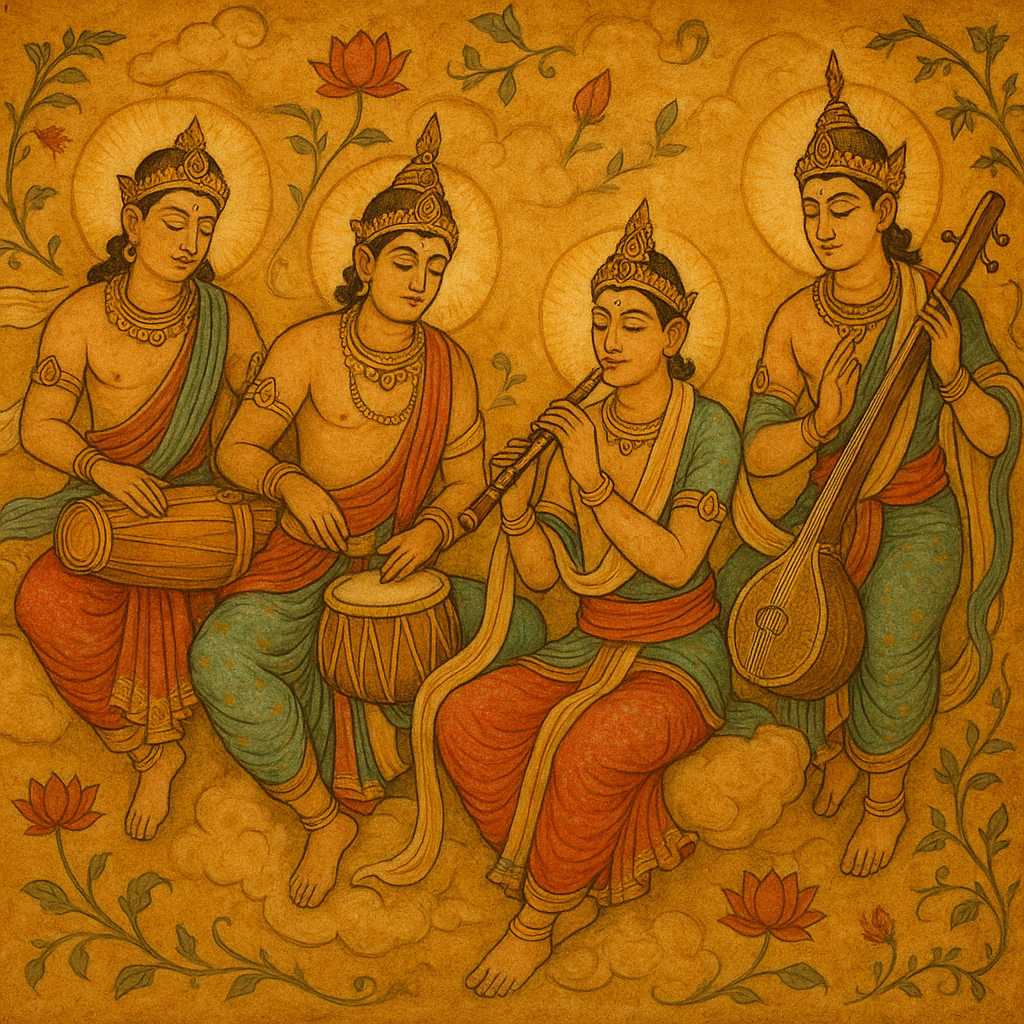
In the rich culture of Indian religious thought, Gandharvas stand out as celestial beings devoted not to war or wisdom, but to art, music, and aesthetic power. They are not gods, yet far beyond humans—divine performers who serve as intermediaries between realms, guardians of sacred sound, and symbols of creative transcendence.
This article offers a detailed look at the origins, nature, roles, and symbolic meaning of Gandharvas, and compares them to other similar entities within Hindu and Buddhist cosmology.
1. Who Are the Gandharvas?
Gandharvas are male celestial beings found in Hindu and Buddhist texts, known primarily for their role as musicians of the heavens. They reside in the upper worlds—especially the court of Indra, king of the gods—and are tasked with performing music during rituals, battles, and cosmic ceremonies.
They are often paired with Apsaras, female celestial dancers. Together, Gandharvas and Apsaras represent the union of sound and movement, embodying the performative and sensual dimensions of the divine.
2. Origins and Lineage
In Hindu mythology:
- Gandharvas are described as the sons of Brahma, or as descendants of the sage Kashyapa and his wife Arishta.
- In some stories, they emerge from the aroma of Soma or from the primordial sound of creation itself.
In Buddhist cosmology:
- Gandharvas are categorized among the eight classes of supernatural beings (ashtasenā) and are generally understood to inhabit the lower deva realms.
- The term gandhabba in Pali refers to a similar being involved in the rebirth process, playing a transitional role between incarnations.
3. Appearance and Characteristics
Gandharvas are consistently portrayed as:
- Handsome, youthful males, radiant in form and expression,
- Dressed in ornate garments, wearing garlands and gold jewelry,
- Holding or playing musical instruments like the veena, flute, tanpura, or mridangam.
Unlike warriors or ascetics, Gandharvas embody refinement, sensitivity, and artistic discipline. Their music is not entertainment—it’s an offering, a tool of cosmic balance, and an instrument of divine communication.
4. Roles and Functions
4.1. Divine Musicians
Gandharvas perform in Indra’s celestial court, providing music during divine assemblies and battles. Their music is believed to stabilize cosmic order, uplift the gods, and sanctify rituals.
4.2. Guardians of Soma
In Vedic hymns, Gandharvas are entrusted with guarding Soma, a sacred plant or elixir associated with immortality and divine insight. Their control over Soma suggests a link to esoteric knowledge and spiritual intoxication.
4.3. Witnesses of Love
One of the classical types of marriage in Hindu law is the Gandharva marriage—a union based solely on mutual love and desire, without rituals or family sanction. This form, named after the Gandharvas, underscores their association with romantic spontaneity and sensual freedom.
4.4. Intermediaries of Rebirth (in Buddhism)
In some Buddhist texts, a gandhabba (Pali) is the being that connects karmic energy to a physical body during conception. This gives Gandharvas a liminal, metaphysical role, bridging the gap between death and new life.
5. Appearances in Sacred Texts
- Rigveda: Gandharvas are praised as aerial beings linked to fragrance, music, and Soma.
- Mahabharata: The Gandharva Chitraratha confronts Arjuna and the Pandavas before becoming an ally.
- Ramayana: Ravana defeats the Gandharva king Vishvavasu to conquer the island that becomes Lanka.
These appearances reflect their complex role—not just entertainers, but actors in major mythological conflicts and transformations.
6. Symbolism
Gandharvas symbolize several core ideas in Indian spiritual philosophy:
| Theme | Gandharvas Represent |
|---|---|
| Sound and Vibration | The universe is born from nāda (primordial sound); Gandharvas embody it. |
| Aesthetic Experience | Spiritual truth expressed through beauty, music, and art. |
| Transience and Emotion | Like music, they are fleeting but powerful, rooted in feeling. |
| Sacred Sensuality | Desire as a valid, even sacred, force when aligned with cosmic order. |
They are a reminder that spiritual life is not only about silence or renunciation—it can also be rooted in harmony, creativity, and refined sensual experience.
7. Related Celestial Beings in Hindu and Buddhist Traditions
Apsaras
- Female counterparts of Gandharvas.
- Celestial dancers who often accompany Gandharvas in performances.
- Represent movement, beauty, and seductive charm.
- Frequently involved in stories about testing sages or seducing humans.
Kinnaras
- Mythical beings with human and animal features (often half-horse or half-bird).
- Known for music and poetry, especially in Buddhist texts.
- Sometimes conflated or confused with Gandharvas but are distinct in origin and iconography.
Devas
- Full-fledged gods of the Hindu pantheon.
- Gandharvas often serve or assist them, particularly Indra.
Yakshas
- Nature spirits associated with fertility, wealth, and forests.
- More grounded and earthly than Gandharvas but similarly non-human.
Nagas
- Serpent deities who, like Gandharvas, appear in both Hindu and Buddhist traditions.
- Often mystical and protective, but not linked to music or art.
These beings form a cosmic hierarchy where each class represents different aspects of existence—emotion, nature, intellect, force, or beauty.
8. Contemporary Legacy
While few today literally believe in Gandharvas as celestial beings, their symbolic presence persists:
- In Indian classical music, performers are sometimes called “Gandharvas” to signify divine inspiration.
- Gandharvas appear in poetry, theatre, and visual art as archetypes of refined masculinity, artistic mastery, and sensual grace.
- Their themes continue to influence modern retellings of mythology, fantasy literature, and even video games and animation.
They endure as symbols of creative power, reminding us that beauty and sound are not mere distractions—they are part of the sacred.
Gandharvas are more than mythological musicians. They represent a worldview where art is not entertainment, but a means of connection between the human and the divine. Through sound, gesture, and emotion, Gandharvas model a path to transcendence that isn’t built on austerity, but on sensitivity, expression, and inner harmony.
They occupy a rare space in religious tradition—not gods, not mortals, but vital messengers of meaning, reminding us that the universe doesn’t just run—it resonates.
